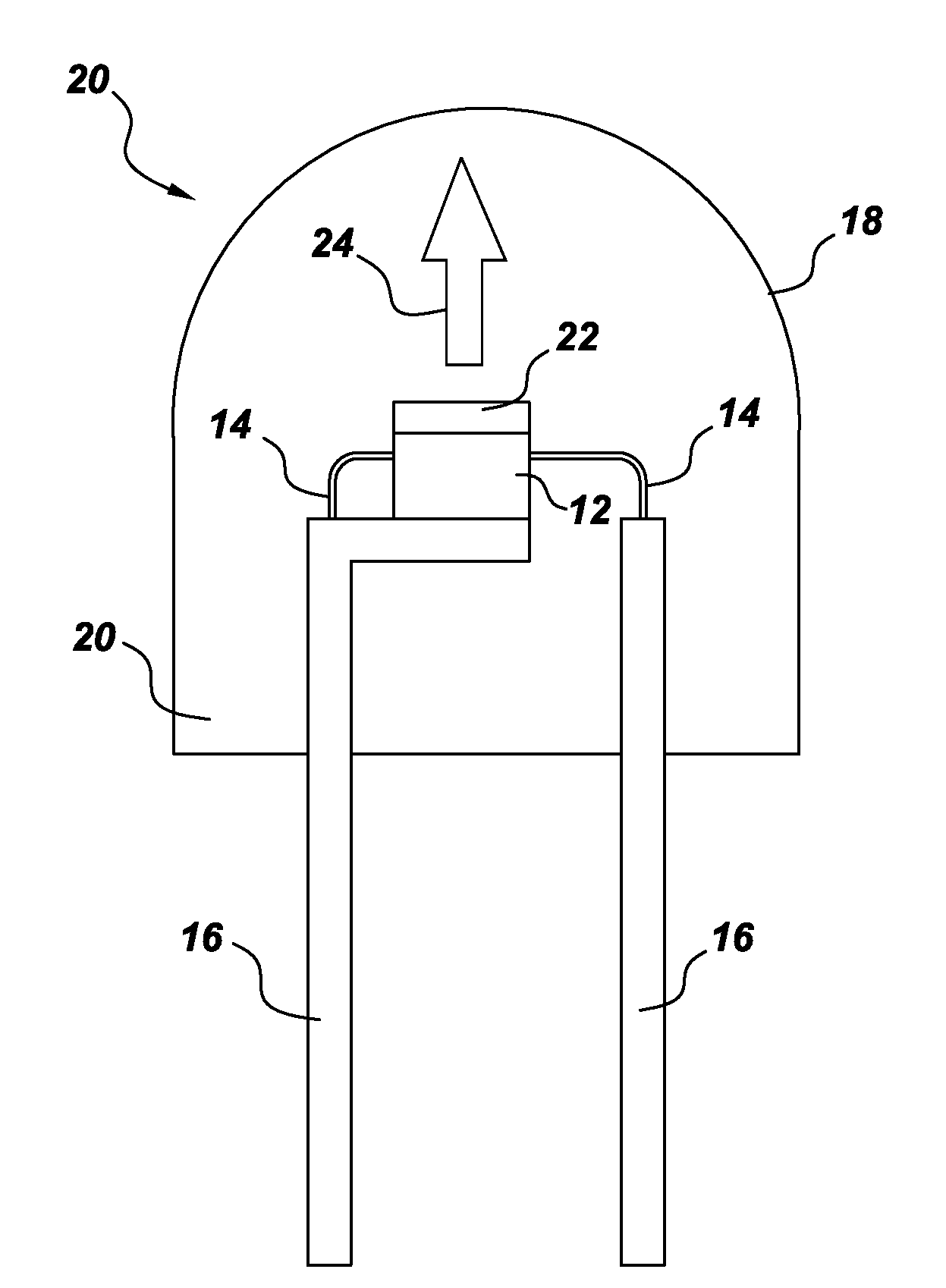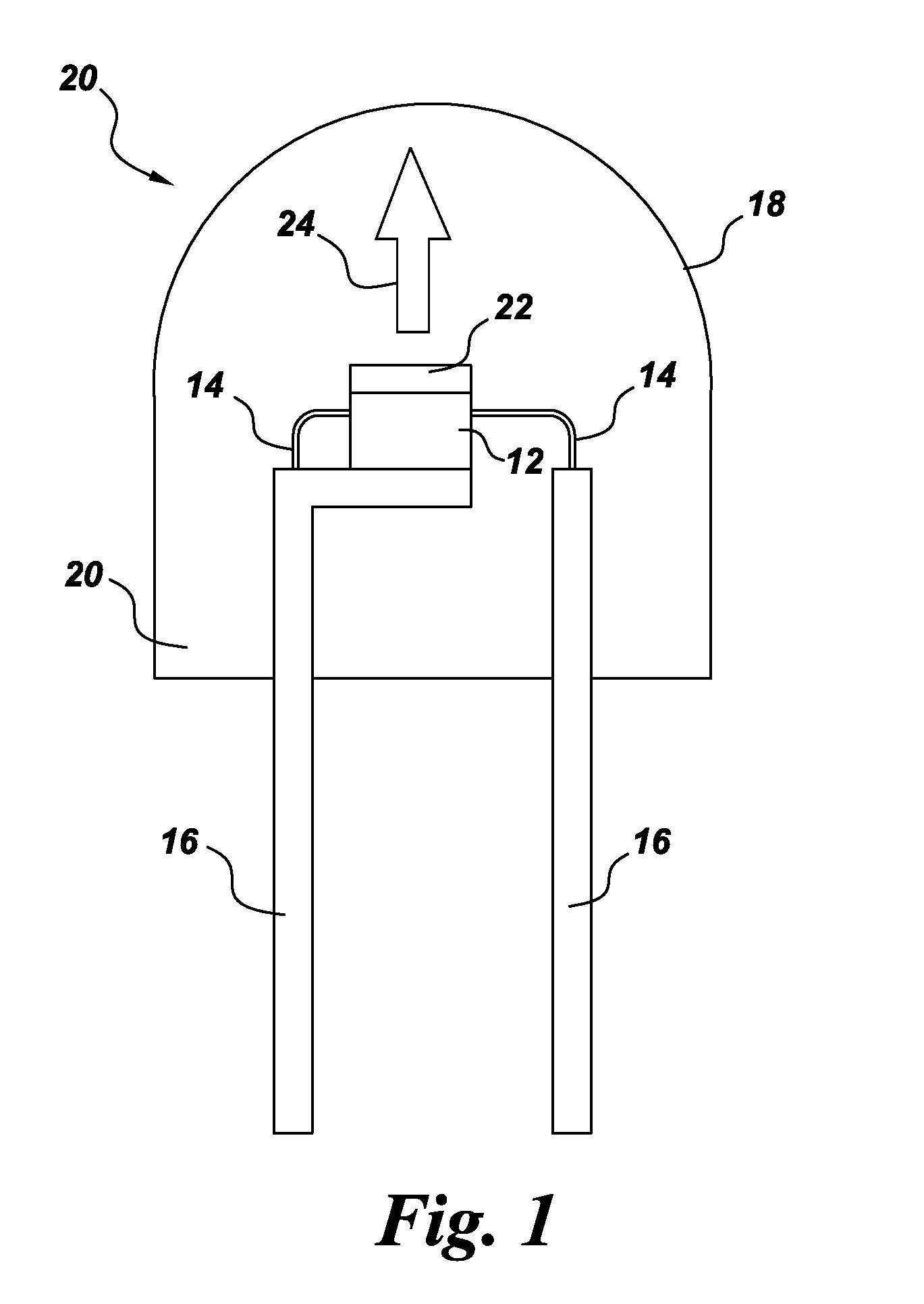Color stable phosphors
a phosphor and stable technology, applied in the direction of discharge tube luminescent screen, discharge tube/lamp details, luminescent composition, etc., can solve the problem that the quantum efficiency of phosphors exposed to higher temperatures may have decreased
- Summary
- Abstract
- Description
- Claims
- Application Information
AI Technical Summary
Benefits of technology
Problems solved by technology
Method used
Image
Examples
example 1
SASOF Phosphor Synthesis
[0041](Nominal composition: (Sr0.895Ca0.1Ce0.005)3Al0.6Si0.4O4.415F0.585)
Starting materials:
SrCO3 (Aldrich)193.74 gCaCO3 (Aldrich) 17.44 gCeO2 (Alfa Aesar) 1.50 gα-Al2O3 (Ceralox) 17.76 gCAB-O-SIL TS-610 (Fumed SiO2) 13.96 g
[0042]The materials were dry-blended for four hours and fired at 1100 / 8 hours / air in an open alumina crucible. The resulting combined aluminate-silicate precursor is then blended with 29.745 g SrF2 for 2 hours in a open alumina crucible. The phosphor cake was then broken up with a mortar and pestle and then milled in isopropanol until a median particle size of 16-20 μm was reached. After milling the phosphor was placed into a beaker with isopropanol and stirred with a magnetic stir bar. The stirring was then stopped and the larger particles settle to the bottom of the beaker and any fine particles are suspended in isopropanol are decanted. Additional isopropanol was added to make a slurry with the remaining phosphors. This slurry was passe...
example 2
Treatment with Coating Precursors
[0043]Phosphors were reacted with silicate or phosphate precursors to create a barrier that separates the moisture sensitive phosphor from the atmosphere, thereby reducing or eliminating reactions between the phosphor and components of the atmosphere. Reaction of the phosphor with components in the atmosphere (H2O and / or possibly CO2) may result in a decrease in both absorbance and quantum efficiency. Four different materials / precursors were used as coating materials for the SASOF phosphor (all samples were from the same SASOF batch): Na2SiO3, BN, Si(OC2H5)4 (tetraethyl orthosilicate or TEOS), and submicron SiO2.
[0044]Experimental conditions are summarized in Table I. The procedure for Coating #2 is here described in detail as an example.
[0045]Na2SiO3 (0.5 g) was dissolved in 50 g of ethylene glycol (C2H6O2). The pH of the resulting solution was adjusted to 4.7 using H2SO4. The SASOF phosphor prepared in Example 1 was added to this solution, the pH w...
example 3
[0048]A second trial was carried out focusing on the best performing (#4) coating material from the first trial, (TEOS), as well as introducing a new coating material diammonium phosphate (DAP). The experimental conditions for the second trial coating experiments are summarized in Table 3. The procedure for treatment with DAP is described in detail as an example.
Materials
[0049]SASOF phosphor: 5 g
(NH4)2HPO4 (DAP): 33.0 g
Deionized H2O (DI H2O): 250 mL
[0050]DAP was fully dissolved in room temperature DI H2O to given an approximately 1M solution of DAP. The SASOF phosphor was added to this solution and this slurry was magnetically stirred for 30 min. After 30 minutes, the solution was filtered out and the filtrate was washed with DI H2O. The filtrate was then dried in air using a heat lamp.
TABLE 3SASOFEthanolTEOSH2OExample #mass (g)(mL)(mL)(mL)pHComment3.135125255010.2No pH adjustment3.23512525503Used H2SO43.36294.413Low concentrationwater, used H2SO43.46224.48.811used NH4OH3.56204.4203...
PUM
| Property | Measurement | Unit |
|---|---|---|
| temperature | aaaaa | aaaaa |
| wavelength | aaaaa | aaaaa |
| wavelength | aaaaa | aaaaa |
Abstract
Description
Claims
Application Information
 Login to View More
Login to View More - R&D
- Intellectual Property
- Life Sciences
- Materials
- Tech Scout
- Unparalleled Data Quality
- Higher Quality Content
- 60% Fewer Hallucinations
Browse by: Latest US Patents, China's latest patents, Technical Efficacy Thesaurus, Application Domain, Technology Topic, Popular Technical Reports.
© 2025 PatSnap. All rights reserved.Legal|Privacy policy|Modern Slavery Act Transparency Statement|Sitemap|About US| Contact US: help@patsnap.com


